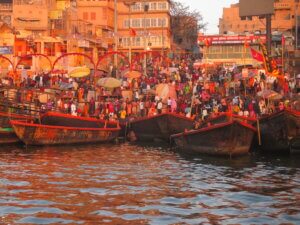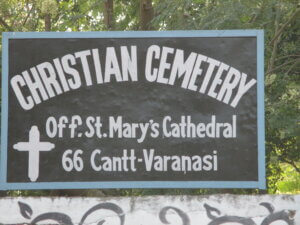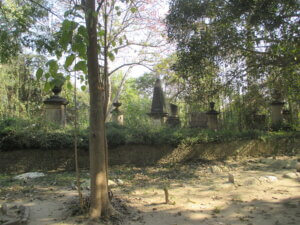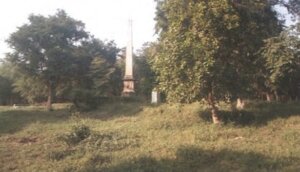Chairman’s Trip To India, February/March 2024 (Part 3)
Varanasi
Paul Dean, Chairman of BACSA, and his wife Moira recently visited several historical sites in India, as part of a long-awaited extended trip to mark their retirement.
This post, the third in a series, covers places visited in Varanasi. Posts about their visits to Hyderabad, Aurangabad and Agra, and to Orchha, Khajuraho and Lucknow were published on 11/5/24 and 28/06/24 respectively. A future post will cover their visit to Darjeeling.

‘Our train got us into Varanasi on time. That evening we went to Dashaswamedh Ghat on the north bank to watch an elaborately choreographed blessing to the Ganges. We had inadvertently arrived on Shiva’s birthday which apparently made it busier than usual; it was certainly busier than going to Twickenham to watch a rugby international, with people forcing their way through the crowd in a sometimes disconcerting fashion.
Having arrived in Morocco last year during Ramadan, I had checked carefully before we booked this trip that we would miss being showered with powdered dye during Holi (once bitten, twice shy) but had overlooked Shivratri. The following morning we saw dawn break over the ghats which was colourful, beautiful and moving even if the water did not look anything like as pure as our guide insisted that it was.
We then went in search of the Old Civil/Chowkaghat Cemetery, on Makbul Alam Road, which is managed by a committee chaired by the Roman Catholic Bishop of Varanasi.

(Photo: P Dean, 2024)

(Photo: P Dean, 2024)
It had been drawn to the BACSA Executive Committee’s attention by Committee member Charles Grieg, as potentially worthy of a project. It sits in a corner of a far larger cemetery and has some fine old graves, many in good condition, though quite overgrown. There were no recent burials in amongst them.
It also has a 50′ high obelisk monument to George Frederick Cherry (the British Resident) and three other men who were murdered by Wazir Ali, the deposed Nawab of Oudh, in January 1799.

(Photo: Chowkidar, Vol 14, No 5, p.109)
I had been trying to make an appointment to meet Bishop Eugene Joseph and was grateful to receive a telephone message from him that he was free the following afternoon.
We duly called on the Bishop the next day at his residence in the grounds of the Roman Catholic Cathedral, which is reasonably close to the cemetery, and had a constructive discussion about the prospects of undertaking a joint project. He had spent some time in Southwark in the relatively recent past and had fond memories of his time there. He gave us an excellent cup of tea and some very tasty homemade cake.
(Following Paul’s return to the UK, BACSA Executive Committee agreed on 10/4/24 to inform the bishop of their wish to take the idea further, and that BACSA would wish to have a copy of the burial records).

(Photo: P Dean, 2024)
Earlier in the day we had visited Sarnath, a major Buddhist site just outside Varanasi, where the Buddha preached his first sermon in 530 BC. It has substantial remains, particularly impressive being those of a huge stupa, the Dhamekh Stupa, and the lower portion of an Ashoka pillar, which dates to the third century BC; its capital is now housed in the museum. It is easy to understand why Nehru had it adopted as India’s national emblem. It is a stunningly beautiful object in remarkable condition. Getting up close to it was one of the highlights of our trip.
We were reminded of a misunderstanding with our guide in Hampi who seemed to want us to part with a 50 rupee note. In fact he only wanted to point out that the stone chariot at the Vitthala temple there now appeared on that note. Impressive though it was, it had nothing on the lion capital!
We thanked the Bishop and headed off for a night sleeper to New Jalpaiguri, where we were to pick up the toy train to Darjeeling after breakfast.
Paul Dean
Ed. note
•The incident in which George Frederick Cherry (British Resident), and three other men (Captain Conway, Robert Graham and Richard Evans) were murdered by Wazir Ali in January 1799 is related by Rosie Llewellyn-Jones in Chowkidar Vol 14 No 5, Spring 2017, p.100.
Rachel Magowan
(Suggestions for BACSA website news items are always welcome – please send them to ‘comms@bacsa.org.uk’)
